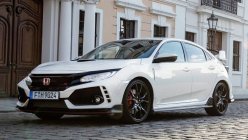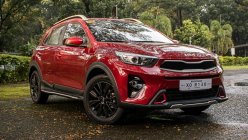Launched in 2020, the Kia Stonic is the Korean marque’s latest entry into the ever-competitive Philippine crossover market. It features a youthful exterior design, loads of practicality, and an ample amount of on-board tech.

The Kia Stonic
Being in a highly contested segment, a prospective car buyer will wonder: how does it fare against its rivals? Specifically, how does it compare against the Geely Coolray, Hyundai Kona, Ford EcoSport, and even the Toyota Rush?
Kia Stonic: Summary of specs
Like most of the models in this article, the Stonic assumes a front-engine, front-wheel-drive layout. Most of them can also seat up to five. The only stand-out model here is the Toyota Rush, which we’ll discuss in detail later.
As for size, the Kia Stonic is 4,100mm long, 1,735mm wide, and 1,533mm in height. It also has a wheelbase length of 2,570mm, and a ground clearance of 185mm.
For exterior equipment, the Kia-made crossover comes standard with projector-type halogen headlamps, LED headlights, front fog lamps, as well a set of 16-inch alloy wheels among others.
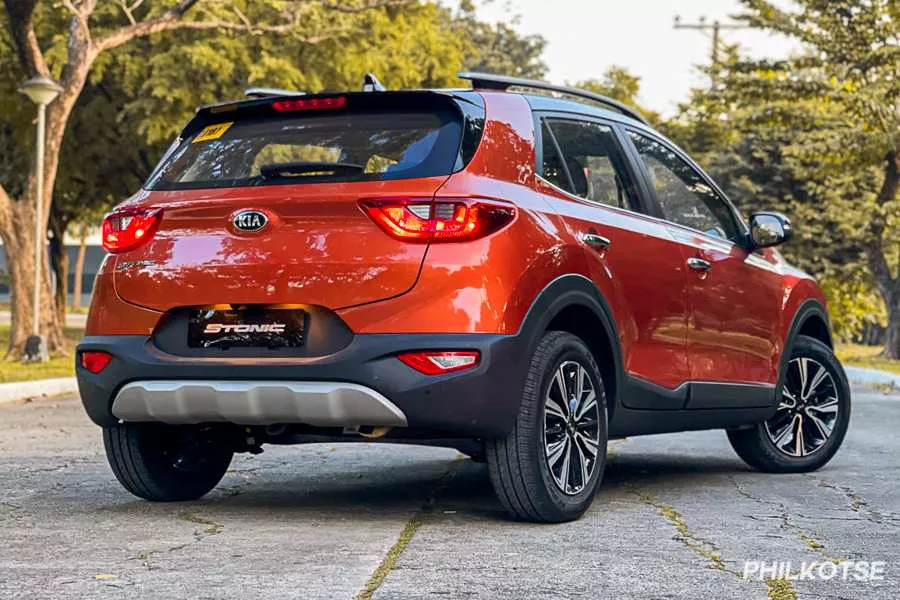
The Kia Stonic from the rear
Inside, all Stonic variants are kitted out with an eight-inch touchscreen that’s capable of connecting to smartphones via Apple CarPlay, Android Auto, Bluetooth, and USB. The said screen is then linked to a six-piece speaker system.
Moreover, the model provides fabric-clad seats, tilt-adjustable steering wheels, an analog gauge cluster, etc. The top-spec model adds on to that with an automatic air-conditioning system, while the rest gets a manual air-conditioning system.
Moving on to safety, the Stonic gets dual-front airbags, anti-lock braking, and ISOFIX child seat tethers. The top-spec Stonic EX has more with its hill-start assist, an engine immobilizer, and electronic stability control.
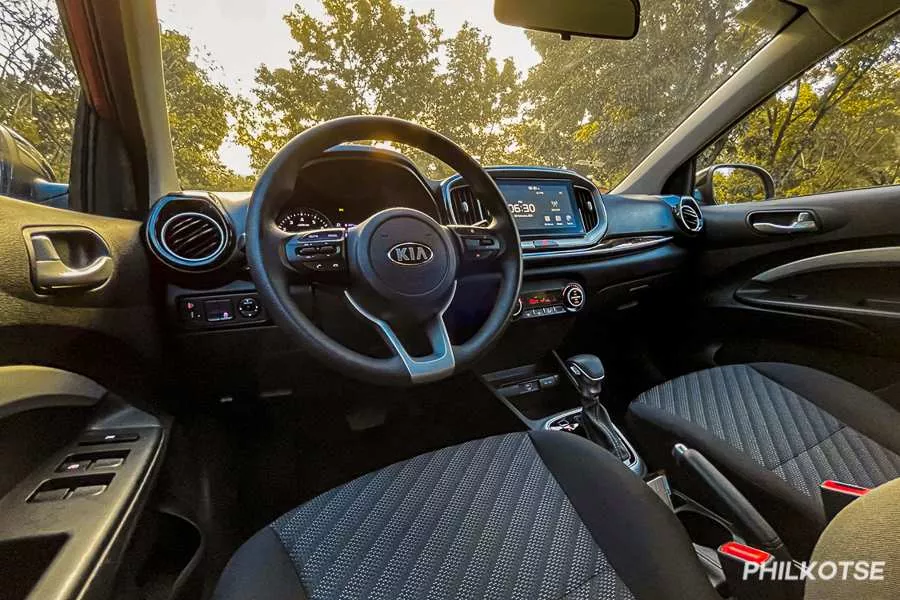
Inside the Kia Stonic
Under the hood, the Stonic uses a 1.4-liter inline-4 gasoline mill. For the five-speed manual transmission variant, it can make up to 94 horsepower and 132 Nm of torque. The six-speed automatic transmission variant meanwhile makes a bit more at 97 horsepower but the same amount of 132 Nm of torque.
Price-wise, the Kia Stonic ranges from Php 735,000 to Php 925,000.
Before reading on, do note that Philkotse.com already has a detailed review article of the Kia Stonic. In the said article, we shared what we thought of this youthful five-seater when we took it out for a test drive.
Kia Stonic vs Geely Coolray
One major competition for the Kia Stonic is the Geely Coolray. It was introduced a bit earlier back in 2019 and like the Kia, it's also a front-engine, front-wheel-drive subcompact five-seater model.
Size-wise, the Coolray is significantly longer than the Stonic with its length of 4,330mm. It is also wider at 1,795mm, and taller at 1,609mm. It also has a slightly longer wheelbase at 2,600mm, and a bit more ground clearance at 196mm.

The Geely Coolray
Moving on to exterior bits, the Coolray also has halogen headlamps, front fog lamps, 17-inch alloy wheels, and LED taillights. Though the top-spec Coolray Sport variant comes with LED headlamps and a larger set of 18-inch wheels.
Inside, the top-spec Coolray features leather seats, a tilt and telescopic steering wheel, and an automatic air-conditioning system. It also has a sunroof, and a larger 10.25-inch touchscreen with Bluetooth, USB, and the QD Link smartphone connectivity software. It is then linked to a four-piece speaker system.
All variants also come with cruise control. In summary, the Coolray offers a more premium interior although its headunit is less capable than the smaller one on the Stonic.
For safety, the highlight of the Coolray is the top-spec variant’s automatic parking assist feature. Essentially, it can park itself, and it is the only model on this list that comes with this feature. Other than that, the Coolray Premium and Sport also has automatic headlamps, and tire pressure monitoring.
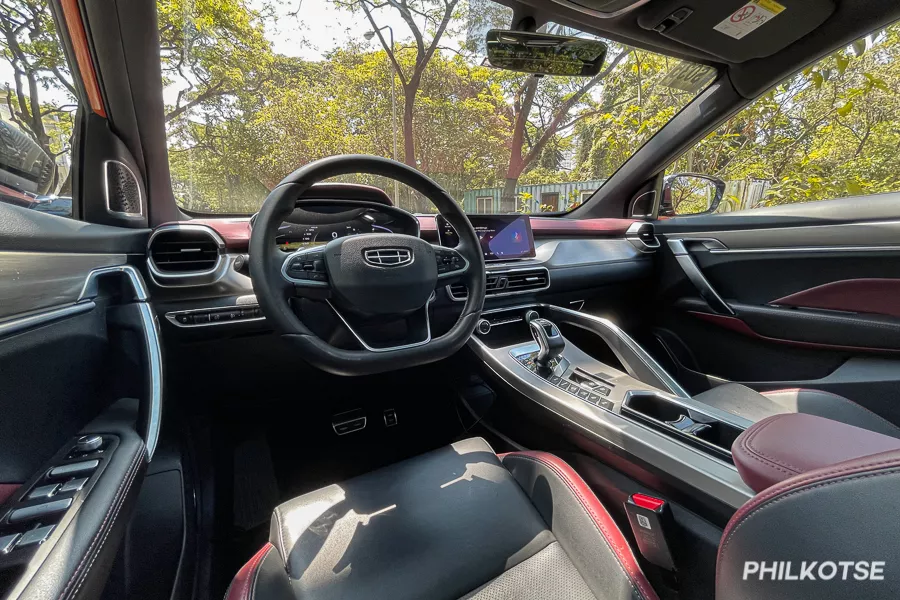
A peek inside the Coolray's cockpit
In comparing the Kia Stonic vs the Geely Coolray in terms of engine output though, it is pretty clear that the Geely model is significantly more powerful. That’s because its 1.5-liter inline-3 turbocharged mill can make up to 177 horsepower and 255 Nm of torque. It also uses a seven-speed wet type dual-clutch transmission which is more complicated than the Stonic’s six-speed automatic tranny.
Price-wise, the Geely Coolray ranges from Php 978,000 to Php 1,198,000.
Kia Stonic vs Hyundai Kona
In comparing the Kia Stonic vs the Hyundai Kona in terms of size, the Hyundai model is slightly longer at 4,165mm. It is also slightly wider at 1,800mm, and a bit taller at 1,550mm. Moreover, it has a longer wheelbase at 2,600mm but it has less ground clearance at 170mm.
Like the Stonic, the Kona comes equipped with halogen headlights, LED taillights, and front fog lamps. Though the Hyundai model comes with a larger set of 17-inch wheels.
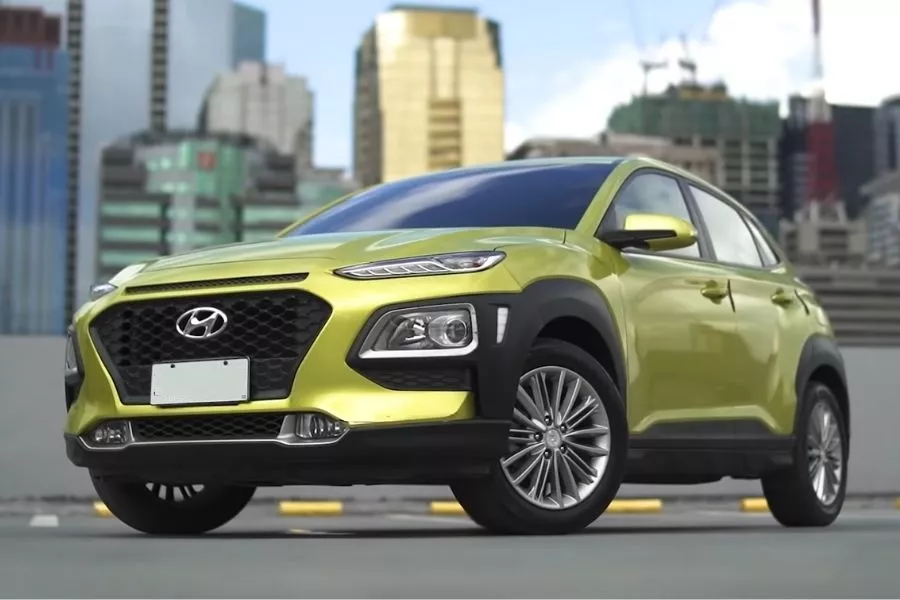
The Hyundai Kona
Inside, the Hyundai Kona can also seat up to five, and its seats are also clad in fabric. The sole variant of the Kona in the Philippines also comes standard with manual air-conditioning, and a 3.5-inch LCD infotainment system with Bluetooth and USB connectivity. The said headunit gets as many speakers as the one on the Stonic numbering at six.
While the aforementioned are simpler than the top-spec Kia Stonic EX’s equipment, the Kona does feature more driver amenities than the Kia model. These include a push-to-start button, and a tilt and telescopic steering wheel.
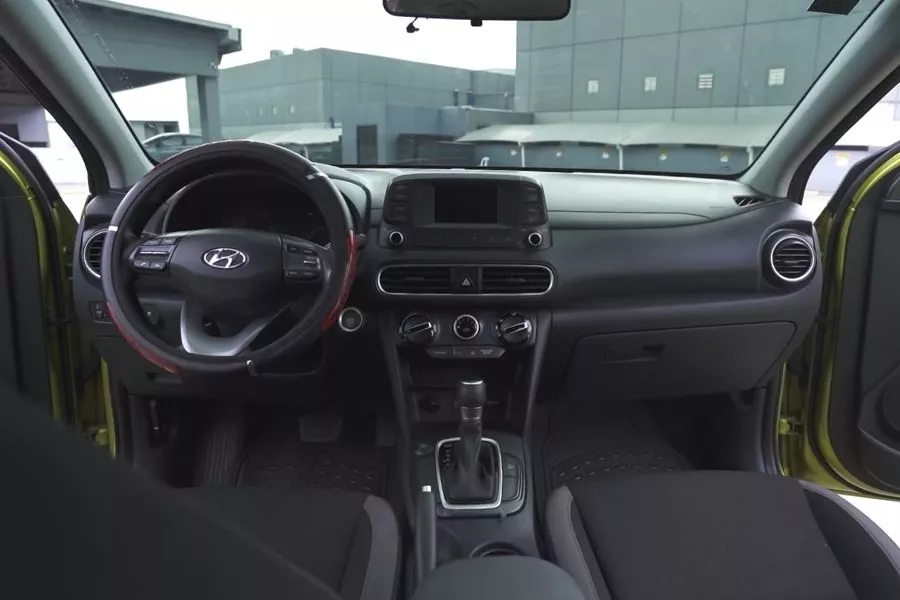
The Kona's cockpit
Propelling the Kona is a 2.0-liter inline-4 gasoline engine. It is more powerful than the Stonic’s 1.5-liter mill, as it can churn out 147 horsepower and 179 Nm of torque. Like the Kia, the Hyundai-made model also uses a six-speed automatic transmission.
The sole variant of the Hyundai Kona for the Philippine market currently has a price of Php 1,188,000.
Kia Stonic vs Ford EcoSport
The Ford EcoSport is one of the more popular competitors to the Kia Stonic. It is a veteran of the local crossover market, and it's been around since 2012. Like the Kia Stonic, it also has a front-engine, front-wheel-drive layout. It can also comfortably seat up to five.
Surprisingly though, the EcoSport is actually larger than the Kia Stonic. This is because it has a length of 4,245mm, a length of 1,765mm, and a height of 1,656mm. However, it has a longer wheelbase length of 2,519mm, and more ground clearance at 209mm.
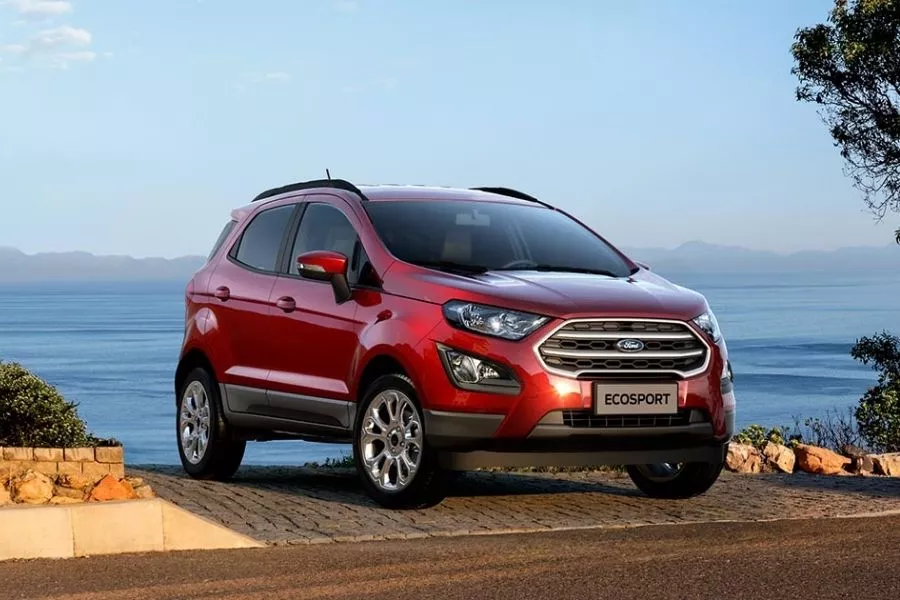
The Ford EcoSport
In comparing the Kia Stonic vs the Ford EcoSport when it comes to exterior equipment, they’re mostly on par with each other. Specifically, the EcoSport also has a halogen headlamp though the top-spec EcoSport EcoBoost Titanium has HID headlamps. All EcoSport trims also come with 17-inch alloy wheels, and front fog lamps.
Do note that the Ford also has some different exterior features in that it has rear halogen lights, and rear fog lamps. The higher trims even come with automatic headlamps with a leveling function and rain-sensing headlamps.
Inside, the top-spec EcoSport has leather seats while the other variants get fabric seats. Most variants however are provided with a tilt and adjustable steering wheel. The higher trims of the EcoSport also have a push-to-start button, rain-sensing wipers, digital gauge cluster, and a power sunroof. Features that are absent on the Stonic.
Furthermore, the EcoSport Titanium trims come standard with an eight-inch touchscreen which unlike the Stonic lacks Apple CarPlay and Android Auto. It does come with Bluetooth, USB, and Ford’s own smartphone connectivity software.
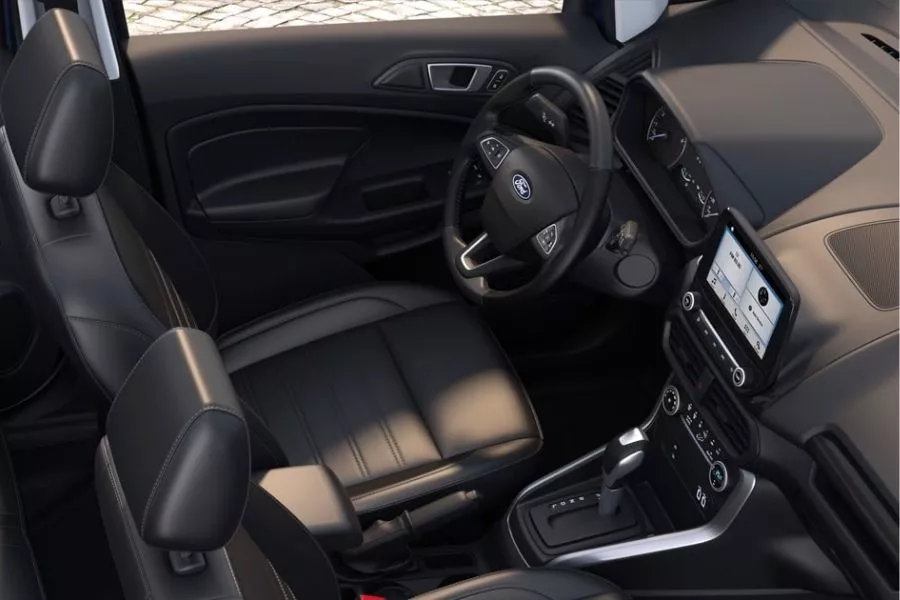
The EcoSport's roomy interior
As for safety, the Ford EcoSport has four airbags, anti-lock braking, stability control, hill-start assist, ISOFIX child seat tethers, traction control, among others. The EcoSport Titanium trims have six airbags. Except for the entry-level EcoSport 1.5 Trend, it also gets hill-descent control. To sum it up, the Ford model clearly has a more comprehensive safety kit than the Stonic.
For power, the EcoSport gets two options which are both more powerful than the Stonic’s 1.5-liter mill. The first one is a naturally-aspirated 1.5-liter inline-4 engine that can make up to 121 horsepower and 150 Nm of torque. The other one is a turbocharged 1.0-liter inline-3 mill that can generate up to 123 horsepower and 170 Nm of torque.
The Ford EcoSport’s price for the Philippine market ranges from Php 799,000 to Php 1,190,000.
Kia Stonic vs Toyota Rush
As strange as it is, some can’t help but compare the Kia Stonic vs the Toyota Rush. The aforementioned Toyota model after all, is still mistaken by a lot of people as a crossover SUV. There’s also the point that one of its variants sits within the same price ranges as the Stonic’s.
To start this off, the Rush is longer but wider and taller than the Kia Stonic. Specifically, it has a length of 4,435mm, a width of 1,695mm, and a height of 1,705mm. It also has a longer wheelbase at 2,685mm, and significantly more ground clearance at 220mm.

The Toyota Rush
The top-spec Rush G AT is also better kitted out when it comes to exterior equipment since it has LED headlamps and a larger set of 17-inch alloy wheels. Then again it also gets LED taillights, and front fog lamps just like the Stonic.
One clear advantage that the Rush has over the Stonic is that it can seat up to seven people. After all, it does have a third-row seat. Remember though that the Rush isn’t actually a crossover SUV, and it's actually more of an MPV of sorts.
Going back to interior features, the top-spec Rush gets automatic climate control, a push to start button, a leather-wrapped steering wheel, among others. Suffice to say, those are better than what the top-spec Kia Stonic has. Like the Stonic however, the Rush also gets fabric seats as standard. There’s also its seven-inch touchscreen which gets Bluetooth, USB connectivity, but lacks the Apple CarPlay and Android Auto that’s available to the Kia crossover. It does get the same number of speakers at six.
For safety though, the Rush gets more equipment. All of its variants come standard with six airbags, hill-start assist, and traction control. And like the Toyota-made model also has anti-lock braking, and ISOFIX child seat tethers.
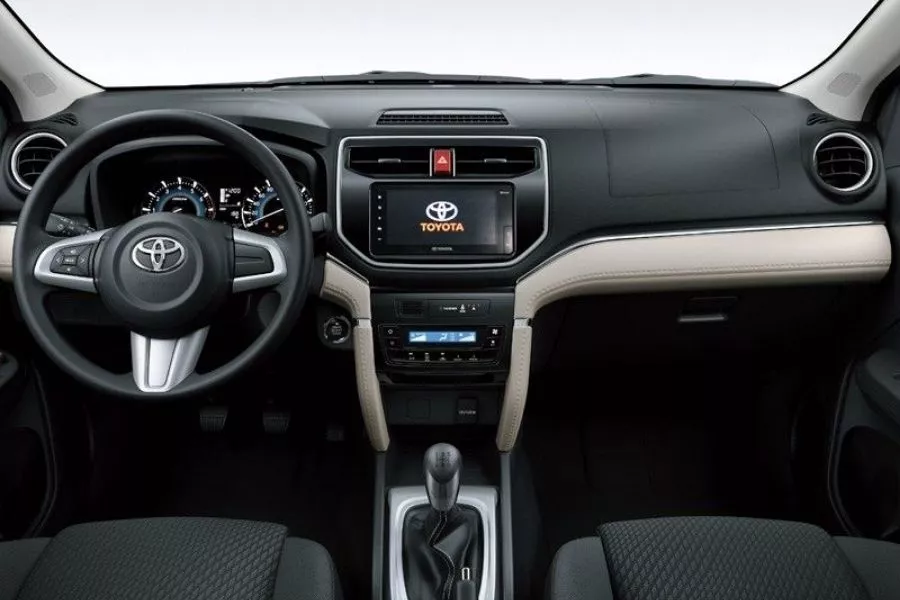
The Toyota Rush's simple but well-arranged interior
Another key difference between the Toyota Rush and the Kia Stonic is that the Rush actually uses half a body-on-frame chassis, and half a unibody frame. To some degree, this makes it sturdier and more capable of dealing with rough roads. Moreover, the Rush uses a front-engine, rear-wheel-drive layout instead of the usual front-wheel-drive that the typical crossover uses.
In terms of engine power, the Rush’s 1.5-liter inline-4 engine can dish out up to 102 horsepower and 134 Nm of torque. It also gets two transmission choices. The Rush E either has a five-speed manual transmission or a four-speed automatic transmission. The Rush G in turn is only available with the aforementioned automatic tranny.
That said, it is a bit more powerful than the Stonic, but only marginally. Plus the Kia model's transmission has more gears than the Rush’s.
Price-wise, the Toyota Rush ranges from Php 983,000 to Php 1,100,000.
Know more about Kia Stonic 2025

The Kia Stonic is a five-seater, subcompact crossover. In the Philippines market, it has four available variants: the Stonic LX 1.4 MT, the LX 1.4 AT, Style Edition 1.4 AT, and the EX 1.4 AT. Currently, Kia Stonic 2023 Philippines price ranging from Php 835,000 to Php 990,000.
Under the hood of all the Stonic trims is a 1.4-liter inline-4 gasoline engine that can make up to 97 horsepower and 132 Nm of torque. It then uses a six-speed automatic torque converter. Only the entry-level LX trim may come with a five-speed manual transmission. The one with the manual has a different engine tune of 94 horsepower.
Size-wise, the Stonic is 4,100mm long, 1,735mm wide, and 1,533mm in height. It also has a wheelbase length of 2,570mm, and a ground clearance of 185mm.
Locally, the Stonic competes against the likes of the Hyundai Venue, MG ZS, Chery Tiggo 2, Ford EcoSport, Geely Coolray, Hyundai Kona, among others.
₱ 835,000 - ₱ 990,000
ExploreRecent posts
- Kia Stonic common issues Aug 10, 2021
- Kia Stonic body color options Aug 12, 2021
- kia stonic financing guide Aug 06, 2021
- 2021 Kia Stonic variant guide May 31, 2023


